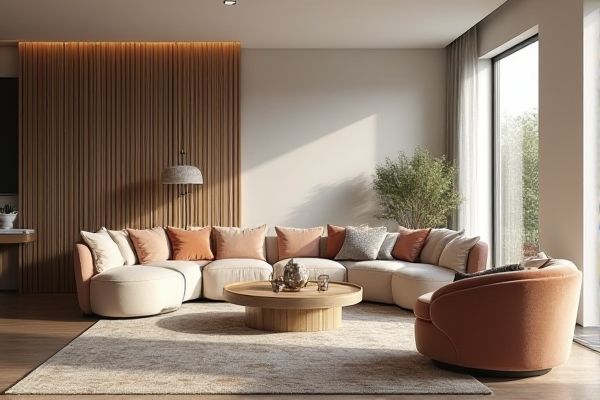
Velvet upholstery offers a luxurious, soft texture with rich colors that add warmth and elegance to any room, while linen upholstery provides a breathable, durable, and natural look ideal for casual or minimalistic decor styles. Explore the rest of the article to discover which fabric best suits your furniture needs and lifestyle.
Table of Comparison
| Feature | Velvet Upholstery | Linen Upholstery |
|---|---|---|
| Material | Soft, dense pile fabric made from silk, cotton, or synthetic fibers | Natural fiber derived from flax plant |
| Texture | Luxurious, smooth, and plush | Lightweight, breathable, and slightly coarse |
| Durability | Moderate; can crush and shows marks easily | High; strong fiber that softens with use |
| Maintenance | Requires professional cleaning; prone to staining | Easy to clean; machine washable in some cases |
| Appearance | Rich color depth with a glossy sheen | Matte finish with natural texture |
| Comfort | Soft and warm to touch | Cool and breathable |
| Cost | Generally higher price point | More affordable and eco-friendly |
| Best Use | Formal living rooms, luxury settings | Casual, coastal, and minimalist interiors |
Introduction to Velvet and Linen Upholstery
Velvet upholstery offers a luxurious texture with a dense pile, providing a rich, elegant look that enhances any furniture piece. Linen upholstery features a breathable, natural fiber known for its durability and subtle, textured appearance, ideal for casual and sophisticated interiors. Your choice between velvet and linen upholstery depends on the desired aesthetic, comfort, and maintenance preferences.
Material Composition and Texture
Velvet upholstery is made from tightly woven fibers such as silk, cotton, or synthetic blends, resulting in a soft, plush texture with a luxurious sheen that enhances depth and richness in furniture. Linen upholstery, derived from natural flax fibers, offers a lightweight, breathable fabric with a slightly coarse texture that provides a casual, organic feel ideal for warmer climates. The dense pile of velvet creates a smooth, tactile surface, while linen's natural weave displays subtle irregularities that contribute to its rustic charm and durability.
Aesthetic Appeal and Style Options
Velvet upholstery offers a rich, luxurious texture with a distinctive sheen, making it ideal for creating elegant, opulent interiors. Linen upholstery presents a natural, breathable fabric with a matte finish, perfect for a relaxed, casual, or Scandinavian-inspired aesthetic. Both materials provide versatile style options, with velvet suited for bold, dramatic accents and linen favoring simple, timeless designs.
Comfort and Tactile Experience
Velvet upholstery offers a plush, soft texture that creates a luxurious and cozy seating experience, making it ideal for spaces designed for relaxation. Linen upholstery provides a breathable and slightly textured surface that feels cool and natural to the touch, perfect for warmer climates or casual settings. Both materials deliver distinct tactile sensations, with velvet emphasizing warmth and softness while linen offers crispness and durability.
Durability and Longevity
Velvet upholstery offers exceptional durability due to its dense weave and resistance to crushing, making it ideal for high-traffic areas where longevity is crucial. Linen upholstery, while naturally strong and breathable, tends to wear faster and may develop wrinkles and stains over time, reducing its lifespan compared to velvet. Choosing velvet often ensures prolonged aesthetic appeal and durability, whereas linen requires more careful maintenance to maintain its appearance.
Maintenance and Cleaning Requirements
Velvet upholstery requires delicate maintenance, often necessitating regular vacuuming and professional cleaning to preserve its plush texture and prevent crushing of fibers. Linen upholstery offers easier cleaning with its naturally breathable and durable fabric, allowing for spot cleaning with mild detergent and occasional machine washing of removable covers. Both materials benefit from prompt stain treatment, but linen generally withstands frequent cleaning better without compromising fabric integrity.
Stain and Fade Resistance
Velvet upholstery offers moderate stain resistance due to its dense pile, but it can be prone to damage from liquids and requires careful maintenance to avoid water marks. Linen upholstery excels in fade resistance, maintaining color vibrancy even under prolonged exposure to sunlight, but it is more susceptible to staining and wrinkles due to its natural fibers. Choosing velvet or linen depends on balancing the need for stain resistance with the importance of color retention in a given environment.
Cost and Affordability Comparison
Velvet upholstery typically costs more than linen due to its luxurious texture and complex manufacturing process, with prices ranging from $30 to $100 per yard compared to linen's $15 to $50 per yard. Velvet requires more maintenance and is less durable than linen, which can increase overall expenses over time. Linen upholstery offers a budget-friendly option with natural breathability and durability, making it more affordable for long-term use.
Best Uses and Suitable Environments
Velvet upholstery excels in formal living rooms and bedrooms, offering a luxurious texture and rich color saturation ideal for low-traffic areas where elegance is prioritized. Linen upholstery is perfect for casual spaces such as sunrooms and family rooms due to its breathable, lightweight nature and durability in warmer, humid environments. You should choose velvet for cozy, sophisticated atmospheres and linen for airy, relaxed settings requiring resilience and easy maintenance.
Pros and Cons: Velvet vs Linen Upholstery
Velvet upholstery offers a luxurious, soft texture and rich appearance, making it ideal for formal settings, but it requires careful maintenance due to its susceptibility to stains and wear. Linen upholstery provides a breathable, naturally durable fabric with a casual, relaxed look, though it wrinkles easily and may show signs of wear faster in high-traffic areas. Choosing between velvet and linen depends on prioritizing aesthetic appeal and comfort versus practicality and ease of care.
 homyna.com
homyna.com